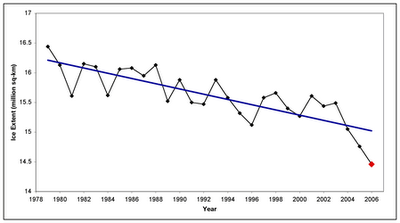The statistics police have issued an all points alert for Eli....
Arctic sea ice has been melting. A new report updates how rapidly. This is bad news for white bears and what is bad news for bears, is often good news for bunnies so there are some smiles at Rabett Labs. However, what concerns us here, and for which we are about to commit statistical suicide is not so much the summer ice anomaly,
but the maximum extent after the winter
It is diving. If you look at the linear regression fit, there has never been a year with a lower sea ice extent that 2006, and the deviation from the linear fit is extraordinary compared to the satellite record from the last 28 years. This should be watched closely next year and the year after. If the curve keeps diving well below the regression line we have entered a new regime for arctic climate.
Monday, November 20, 2006
Subscribe to:
Post Comments (Atom)





9 comments:
Looking at each of the past 3 years in isolation, they don't seem extreme, just a bit above average for decreases, so it simply is that there are 3 decreases in a row. Approximately every 1 in 3 years shows an obvious decrease, so it isn't that exceptional for 3 in a row, so I agree, really needs a couple more years.
It's a truism, but a small section of an exponential curve looks like a straight line. I wonder if we've just started down the "elbow" of the curve...
I asked this over at RC a while ago, and got no takers. What happens if you put a summer ice-free Arctic into the GCMs? The piece you link to suggests that they're beginning to do the work, but only hints darkly at the consequences.
Actually it is four points in a row, and that happened once before, but my worry is that this time it dipped WELL below the line and we are probably well past 2 sigma at this point.
Comparing the two 4 point (or 3-year) drops, it seems to me the 1993 and 2003 points are similar distances above the trend line, but the 2006 point is nearly 2x as far below the trend line as the 1996 point. So I don't think the 1993 to 1996 drop counts as precedent for the 2003 to 2006 drop.
Furthermore, last I checked, NOAA was forecasting above average winter temps for most of the globe, and below average winter temps for nowhere.
Looking at trends in monthly averages using sea ice index I see that while NH sea ice extent is trending down at all times of the year, SH sea ice extent monthly trends, comfortingly, are either flat or upward. But extent is not the whole story.
but my worry is that this time it dipped WELL below the line and we are probably well past 2 sigma at this point.
Ya, looking at the slop of the recent 4 year decline is telling. This is definitely something to keep an eye on next year. Heh, I'm glad we have GRACE. I see the data goes back to the 70's. Any idea how accurate that data is compared to current data?
Just for Gareth... if you remove all the sea ice in a GCM, it regrows
Just for Gareth... if you remove all the sea ice in a GCM, it regrows
Quick, someone tell the Arctic...
I've been thinking about the issue of regrowth a bit. Sure, it happens every winter, but follow me along these lines. If precip falls as snow into the ocean it will melt, cooling the ocean water (heat of fusion and all that), but will not directly form ice. The ice will form from the water, which requires the inverse phase change.
If it falls on ice it sits there and contributes to the thickness of the ice pack.
We can call case 2 the direct mechanism and case 1 the indirect. What is their relative importance? It strikes me that if there is a considerable ice pack after the summer regrowth will be much faster with much of the phase change (from vapor to solid in that case) occurring at altitude.
We have the occasional spam (just erased one), but as long as it remains a minor problem we will keep the comments unguarded (some say that's what they are).
Post a Comment